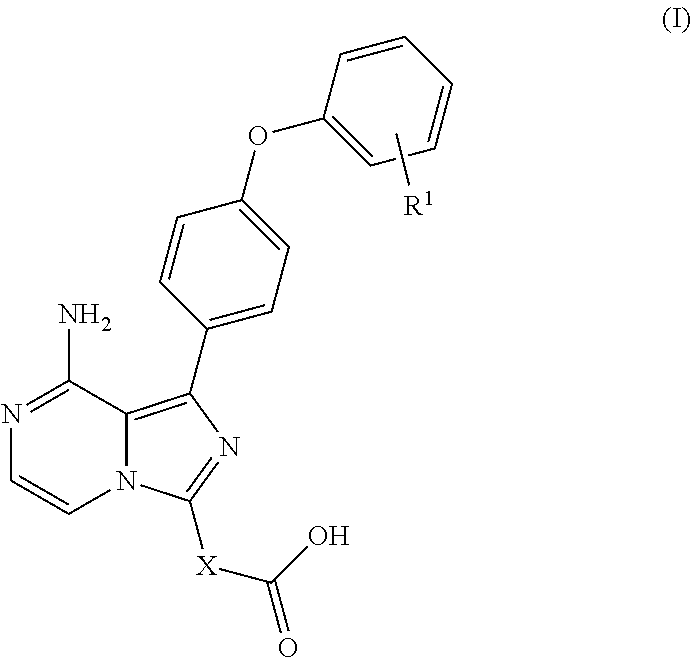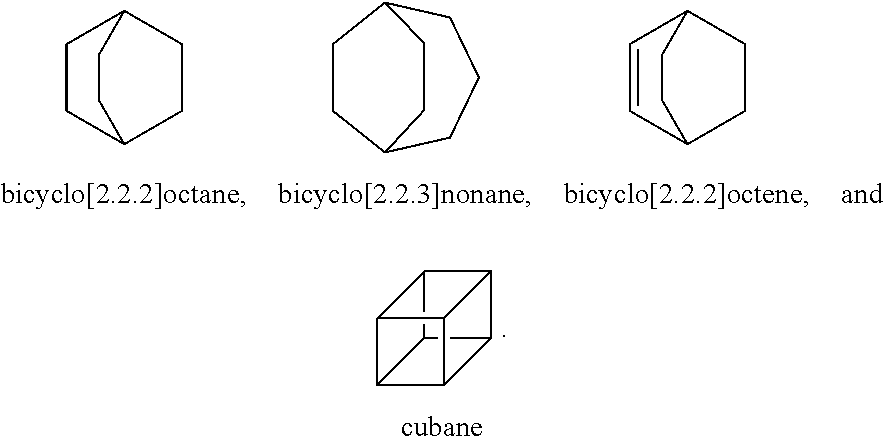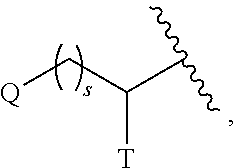Biarylether imidazopyrazine BTK inhibitors
a technology of biarylether imidazopyrazine and inhibitor, which is applied in the direction of drug composition, immunological disorders, metabolism disorders, etc., can solve the problems of serious adverse effects, fyn-deficient mice also show pronounced neurological defects, and are prohibitive for the development of btk inhibitors
- Summary
- Abstract
- Description
- Claims
- Application Information
AI Technical Summary
Benefits of technology
Problems solved by technology
Method used
Image
Examples
example 1
[0380]
(S)-1-(8-amino-1-(4-phenoxyphenyl)imidazo[1,5-a]pyrazin-3-yl)piperidine-3-carboxylic acid
[0381]A solution of (S)-methyl 1-(8-amino-1-bromoimidazo[1,5-a]pyrazin-3-yl)piperidine-3-carboxylate (80 mg, 0.15 mmol) and 4,4,5,5-tetramethyl-2-(4-phenoxyphenyl)-1,3,2-dioxaborolane (65.5 mg, 0.3 mmol) in dioxane (1.5 mL) was added a solution of K2CO3 (95.2 mg, 0.6 mmol), pd (dppf)Cl2 (10.35 mg, 0.014 mmol), then the mixture was heated at 100° C. for 1 hour. After the reaction, the mixture was cooled to room temperature and purified by pre-HPLC to give (S)-1-(8-amino-1-(4-phenoxyphenyl)imidazo[1,5-a]pyrazin-3-yl)piperidine-3-carboxylic acid. 1HNMR (400 MHz, CDCl3): δ=13.79 (br. s., 1H), 11.22 (br. s., 1H), 8.26-8.15 (m, 1H), 7.56 (d, J=8.5 Hz, 2H), 7.41 (t, J=7.5 Hz, 2H), 7.27 (s, 1H), 7.21 (d, J=7.5 Hz, 1H), 7.11 (dd, J=8.0, 16.1 Hz, 4H), 6.11 (br. s., 1H), 4.00-3.88 (m, 1H), 3.57 (d, J=11.5 Hz, 1H), 3.24 (br. s., 1H), 3.01-2.93 (m, 1H), 2.85 (br. s., 1H), 2.48 (d, J=11.5 Hz, 1H), 1.77 ...
example 18
[0383]
(1 S,3R)-3-(8-amino-1-(4-phenoxyphenyl)imidazo[1,5-a]pyrazin-3-1)-2,2-dimethylcyclobutanecarboxylic acid
Step 1: (1S,3R)-methyl 3-(((3-chloropyrazin-2-yl)(4-phenoxyphenyl)methyl)carbamoyl)-22-dimethylcyclobutanecarboxylate
[0384]To a solution of (1R,3S)-3-(methoxycarbonyl)-2,2-dimethylcyclobutanecarboxylic acid (107 mg, 0.576 mmol) and TEA (174 mg, 1.73 mmol) in anhydrous THF (10 mL) was added T3P (403 mg, 1.27 mmol) at 0° C. The mixture was stirred at this temperature for 30 min. (3-chloropyrazin-2-yl)(4-phenoxyphenyl)methanamine hydrochloride (200 mg, 0.576 mmol) was added in aboved solution. The mixture was stirred at 25° C. for further 2 hours. The mixture was treated with ethyl acetate and water. The ethyl acetate layer was separated and was washed with brine, dried over Na2SO4, filtered and concentrated. The residue was purified by silica gel column chromatography (PE / THF=3 / 1) to afford (1S,3R)-methyl 3-(((3-chloropyrazin-2-yl)(4-phenoxyphenyl)methyl)carbamoyl)-2,2-dimethy...
example 30
[0389]
Trans-3-(8-amino-1-(4-phenoxyphenyl)imidazo[1,5-a]pyrazin-3-yl)cyclohexanecarboxylic acid
Step 1: trans-3-(((3-chloropyrazin-2-yl)(4-phenoxyphenyl)methyl)carbamoyl)cyclohexanecarboxylic acid
[0390]To a solution of trans-cyclohexane-1,3-dicarboxylic acid (195 mg, 1.132 mmol) and TEA (238 mg, 2.4 mmol) in anhydrous THF (10 mL) was added HATU (430 mg, 1.1 mmol) at 0° C. The mixture was stirred at this temperature for 30 min. (3-chloropyrazin-2-yl)(4-phenoxy phenyl)methanamine hydrochloride (200 mg, 0.576 mmol) was added in aboved solution, and the resulting mixture was stirred at 25° C. for 2 hours. The mixture was treated with EA and water. The EA layer was separated and was washed with brine, dried over Na2SO4, filtered and concentrated. The residue was purified by silica gel column chromatography (PE / THF=3 / 1) to afford trans-3-(((3-chloropyrazin-2-yl)(4-phenoxyphenyl)methyl)carbamoyl)cyclohexane carboxylic acid as a solid. MS-ESI (m / z): 466.2 (M+1)+ (Acq Method D; Rt: 1.247 min)...
PUM
| Property | Measurement | Unit |
|---|---|---|
| weight | aaaaa | aaaaa |
| weight | aaaaa | aaaaa |
| weight | aaaaa | aaaaa |
Abstract
Description
Claims
Application Information
 Login to View More
Login to View More - R&D
- Intellectual Property
- Life Sciences
- Materials
- Tech Scout
- Unparalleled Data Quality
- Higher Quality Content
- 60% Fewer Hallucinations
Browse by: Latest US Patents, China's latest patents, Technical Efficacy Thesaurus, Application Domain, Technology Topic, Popular Technical Reports.
© 2025 PatSnap. All rights reserved.Legal|Privacy policy|Modern Slavery Act Transparency Statement|Sitemap|About US| Contact US: help@patsnap.com



